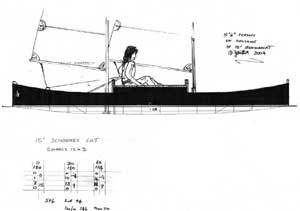A letter from a reader about Jeff's Roonio design:
Hi,
Just a brief comment. I too am poor. So I too build cheap boats, but to see one featured that is of such a discredited design floors me.
In the fifties tank testing proved the assymetrical cat to have a huge drag penalty over symetrical hulls.
That this "designer" is unaware of the basic realities of cat design is sad. What about hull speed wave interference and the myriad of other considerations that he must be equally unaware of? I remember looking through all the yards around Marina Del Rey 35 yrs. ago. I was looking for a cheap boat maybe a dammaged one to repair. Well in almost every yard was a nice but unwanted asymetrical hulled cat. I don't remember the name of the design, but when their owners saw a Hobie sail they never went out in those dogs again.
I guess in sailing as in politics if you forget history you're doomed to repeat it.
Now, don't get me wrong many old designs are both as good or better than what most of us sail now. Bill Roue's Bluenose Sloop 23' cuddy daysailor in continuous production for over fifty years for example. Or the masterpieces by L.F.Herreshoff or his daddy Nat.
I just feel sad to see someone put time and money into a design so obiously unworthy of the effort.
thanks,
Cat
Jeff Gilbert Replies:
Dear Cat,
Thank you for your enthusiastic critique of Roonio.
Many Hobies have assymetric hulls.
I wont get into the intricacies of assymetric lift and drag in this forum as the subject has been well covered by the likes of Tom Speer as has inter-hull interference by Lazarus & Tuck.
In fact the greatest penalties in Roonio you missed completely so I'll add them for you.
1/ weight of robust ply construction for knockabout use. (Try reading Beuhler's highly entertaining and enlightening "Backyard Boat Building" for an extreme but valid view on this subject .) 2/ Friction drag of Bolger-style square section chine hull over a semicircular bottom.
3/ wave slap of dory style flat bottoms (here counteracted to some extent by strong and slim forrd sections) You also missed the fact that
4/ The assymetric hull form tends to turn downwind when pressed (this is dealt with by sail lead, dynamic lift and in Pauls case via slightly oversize rudders).

You equally missed the argument that causes Hobie Alter to use assymetric hull forms so successfully - the more deeply buried leeward hull creates net lift to windward to the extent that the boat can be sailed adequately (not
optimally) sans
daggers. Again Mr Tom Speer is far more eloquent on the subject than myself.
Its undeniable that a displacement hull form of Roonio's waterline length to beam produces a much improved speed to length versus power to weight curve characteristic. Its further undeniable that cobbling two such hulls into a catamaran form enables the power to weight of the boat to be vastly enhanced over a keelboat. The result is anything up to 2.5 times the speed to length.
The advantage is so great that it is possible to compromise quite viciously to vastly simplify the construction, and yet still retain a net speed to length ratio that will make the boat noticeably faster than a monohull of equivalent weight and length.
That is if speed is the issue, which it isn't. Roonio also has a highly non-optimal sail plan which is cheap and simple to sew or even build from polytarp, but safe, eminently controllable, easily tensionsed, and fun.
The boat in standard form wont even lift a hull in less 30 knots of wind.
The design aims of the boat were those requested: A robust safe beachable and demountable craft without appendages that was simple, error-free, and rewarding to construct for a not overly confident first-time builder. The boat was to bear some relationship to the traditional double canoe or proa form.
Room for two to have a sand-free sleep after a beach campfire, room to sit in comfort, space to keep sleeping bags dry (rare on beach cats) were discussed, optimal speed was not.
It was a particular set of requirements for a particular person, and two other younger men, the Moffitts, became interested, Paul building one.
All thoroughly enjoyable and totally non optimal.
Plans are not for sale as yet, and may never be. Paul Moffit seems to have enjoyed the project.
Cheers
Jeff Gilbert

